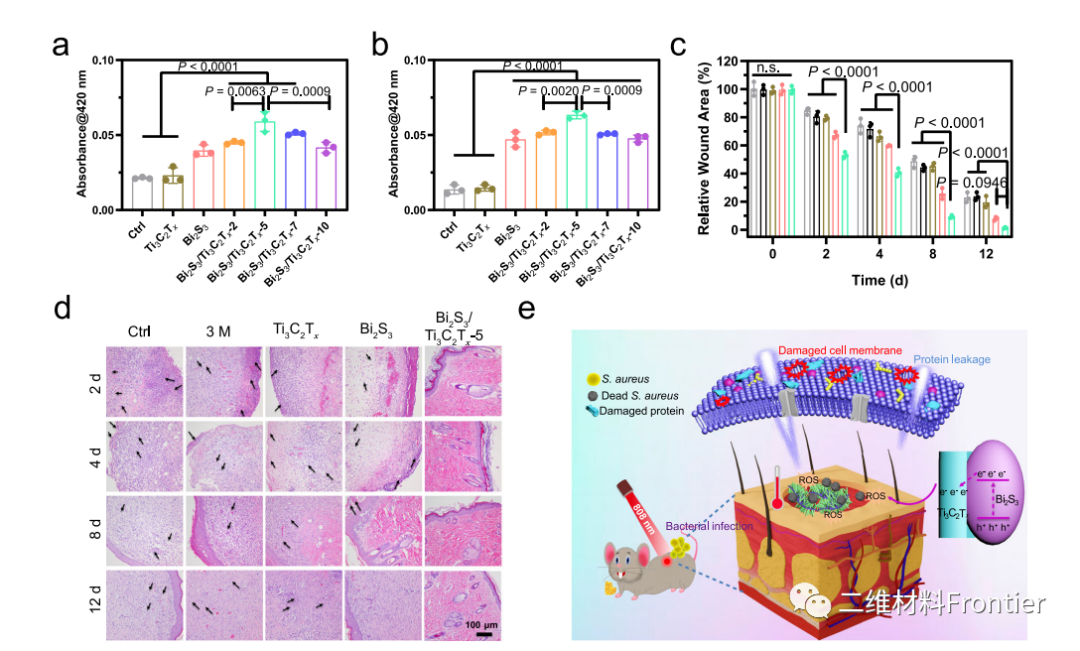
hotline£º
17715390137
Tel/Wechat£º
18101240246 (Technology)
0512-68565571
Email£ºmxenes@163.com £¨Sales Engineer£©bkxc.bonnie@gmail.com
Scan the code to follow or search the official account on WeChat:
2D Materials Fronrier After paying attention,
click on the lower right corner to contact us,
Enter enterprise WeChat.
Professional Services Online

I. Overview of the article.
In view of the improvement of drug resistance, eco-optoelectronic materials are promising substitutes for antibiotics. Here, because of the contact potential difference between Ti3C2Tx and Bi2S3, the interface Schottky junction of Bi2S3/Ti3C2Tx is designed in this paper.Different working functions induce the formation of local electrophilic / nucleophilic regions, and the self-driven charge transfer across the interface increases the local electron density on Ti3C2Tx. The resulting Schottky barrier suppresses the reflux of electrons and promotes the transfer and separation of charges. The photocatalytic activity of Bi2S3/Ti3C2Tx greatly increased the amount of active oxygen under 808nm near infrared radiation. They kill 99.86% of Staphylococcus aureus and 99.92% of E. coli in 10min. In this paper, the theory of interface engineering based on working function is proposed, and the ecological photoelectric response Schottky junction is designed by using two components with different working functions, which can effectively eradicate bacterial infection.
Second, guided reading of picture and text.

Figure 1.
The characterization of Ti3C2Tx/Bi2S3.
An and b are TEM images mapped by Ti3C2Tx/Bi2S3 and EDS elements.
C is the Ti3C2Tx/Bi2S3 in HRTEM.
D is the crystal structure of Ti3C2Tx, Bi2S3 and Ti3C2Tx/Bi2S3 after structure optimization.

Figure 2.
Photocatalytic and photothermal properties of Ti3C2Tx, Bi2S3, Bi2S3/Ti3C2Tx-2, Bi2S3/Ti3C2Tx-5, Bi2S3/Ti3C2Tx-7 and Bi2S3/Ti3C2Tx-10.
An is the use of DCFH fluorescent probe (200ppm). The data were shown as the average ¡Àstandard deviation from the representative experiment (independent sample of nautical 3).
B is the optical flow response under 808nm NIR irradiation.
C is the 325nm excitation wavelength from 350nm to 350nm600 nano-spectrum.
D is the EIS test with or without 808nm exposure.
E is the photothermal curve of different samples under 10 min light (808nm) irradiation.
F is the temperature rise and cooling curve of Bi2S3/Ti3C2Tx-5 when the irradiation is below 808nm.

Figure 3.
The mechanism of interface engineering based on work function.
An is the UPS spectrum measured by HeI (h v = 21.22eV), that is, the secondary electron cutoff of Ti3C2Tx and the valence band of Bi2S3 and Bi2S3/Ti3C2Tx-5 Schottky catalysts relative to Fermi level (EF).
B is the ESR spectrum of Bi2S3/Ti3C2Tx-5 hydroxyl groups.
C is the ESR spectrum of superoxide radical of Bi2S3/Ti3C2Tx-5.
D is the energy scheme before and after contact between Ti3C2Tx and n-type Bi2S3. W is the working function, Eg is the energy gap, Ec is the minimum value of conduction band, and Ev is the maximum value of valence band.
E is the heterostructure of Schottky based on Bi2S3/Ti3C2Tx, which is the mechanism of increasing the yield of ROS through the progress induced by NIR.

Figure 4.
Antibacterial activity in vitro.
An and b are the hydrolysis of Staphylococcus aureus (a) and Escherichia coli (b) after 10min such as Ti3C2Tx, Bi2S3, Bi2S3/Ti3CT2Tx-2, Bi2S3/Ti3T2Tx-5, Bi2S3/Ti3Ti32Tx-7 and Ti3C2Tx-10 in vitro.
C is the quantitative results of staphylococcus aureus 2, 4, 8, 12 days control, 3M wound bandaging, Ti3C2Tx, Bi2S3 and Bi2S3/Ti3C2Tx-5 (10 ¦Ì L, 1¡Á108CFU / mL) on infectious wound healing in vivo. The gray circle represents the Ctrl group, the black circle represents the 3M group, the brown circle represents the Ti3C2Tx group, the pink circle represents the Bi2S3 group, and the green circle represents the Bi2S3/Ti3C2Tx-5 group.
D was the histological image of wound tissue stained with hematoxylin and myosin on the 2nd, 4th, 8th and 12th day.
E is the schematic diagram of Bi2S3/Ti3C2Tx Schottky catalyst and the antibacterial mechanism diagram of Bi2S3/Ti2S3C2Tx under 808nm irradiation. The data were shown as the average ¡Àstandard deviation from the representative experiment (independent sample of nautical 3).
III. Summary of the full text.
The Schottky wire junction between Bi2S3/Ti3C2Tx and built-in electric field has been successfully prepared by the authors. Under 808nm NIR light irradiated 10min, its high photoelectric germicidal efficiency against Staphylococcus aureus and Escherichia coli was 99.86% and 99.92%, respectively. Potential mechanisms include enhanced photocatalysis and photothermal properties, which originate from the rapid transfer of photogenerated charge at the interface, the deep defects of Bi2S3 and the LSPR of Ti3C2Tx after close contact. The difference between the working functions of Ti3C2Tx and Bi2S3 leads to the contact potential difference, which forces the charge transfer of the light source across the interface, increases the local electron density on the Ti3C2Tx, and reduces the recombination of electron-hole pairs. In this paper, a biocompatible Schottky junction with high NIR response bactericidal performance was designed by making use of the functional differences between components and enhancing the photocatalytic and photothermal properties. This study provides new insights into the design of optoelectronic devices for specific applications using two or more components with different working functions.
This information is from the Internet for academic exchange only. if there is any infringement, please contact us to delete it immediately.

| Reminder: Beijing Beike New Material Technology Co., Ltd. supplies products only for scientific research, not for humans |
| All rights reserved © 2019 beijing beike new material Technology Co., Ltd ¾©ICP±¸16054715-2ºÅ |